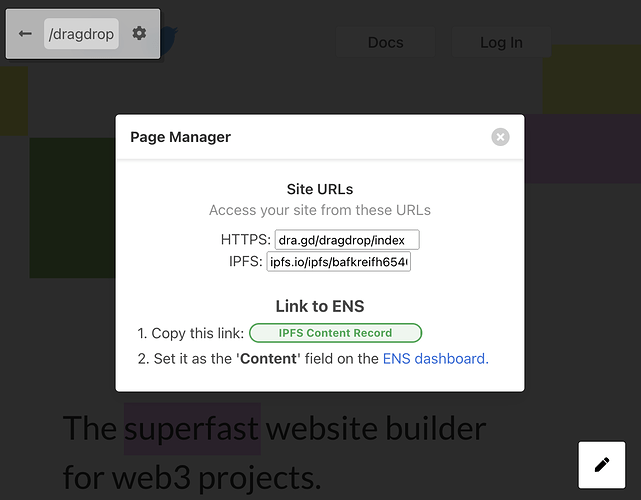Posting here as guided by @alisha.eth and @slobo.eth
What is dra.gd?
dra.gd is a decentralised website builder. Our vision is to build Wordpress for Web3, with the goal of simplifying the site building experience for users while using decentralised architecture.

dra.gd offers a simple drag-and-drop editor with various blocks for users to design a site. Blocks range from simple units like text, button and links, and also include more complex blocks like smart-contract integration and an AI-based image generator.
All sites and assets used on dra.gd are deployed to IPFS and linked to your ENS domain, allowing you to set up a fully customisable blog or profile page, and link it to yourname.eth in just a few steps.
Over 300 users have created sites with dragd so far. We recently won $3000 in grants at ETHIndia, and we’re looking to work closely with the ENS community to build a website builder we all love to use!
Rationale
Products like Wix and Webflow that provide easy-to-use site builders usually involve hosting the site on their centralised service. Export is a premium feature and further requires users to figure out deployment to dWeb as an additional step.
Further, support for Web3 integrations is poor. Plugin support is usually limited to whatever integrations they offer. With Ethereum serving as shared data-infrastructure, projects can simply connect their existing smart contract address to connect data to other plugins on the site. (Eg. a private analytics dashboard for your community, or a private group chat)
Recent Updates
- Started in May 2022, as a hobby project and was conceived at a hackathon.
- We started out with building an intuitive editor that lets people build a website with a figma-like experience.
- Responsive by default - pages designed in dragd effortlessly resize to fit on smaller screens, making the design process much easier.
- The page editor has seen tons of upgrades, including multi-select, new blocks, keyboard shortcuts, a ‘help’ screen, and much more.
- When a new site is created, we immediately deploy a redirect to your dragd site on IPFS which can then be linked to your domain. (not ideal, see roadmap)
- Smart contract support - connect smart contracts to your page and using on-chain data to control actions, like private pages for NFT holders or defi dashboards.
Roadmap
We’ve had a lot of ideas for cool features to add to the editor, but we’d like many of our features to be driven by community feedback. Here is some of the stuff we have planned for the coming months:
-
Link ENS button: For the ETHIndia hack, our demo just linked the site to your primary ENS, but we would like to build a better UI to connect sites and domains.
-
More plugins: Our new plugin system is ready and we’ll be adding new blocks to try out on your site.
-
Static build and deploy: Currently sites are still hosted on our centralised server, with just a redirect deployed to IPFS. This also makes our sites indexable on Esteroids.
With this change, dra.gd will no longer require a centralised server, as the editor itself can be hosted on IPFS, with just a build service run on some decentralised compute provider.
-
Better flows for creating blogs and profile pages, with good defaults and a fun user experience to set it up.
-
Delegation support: Currently we just update the content hash. We’d like to look into delegation support as a part of the roadmap for subdomains and making updates on user’s behalf.
-
Subdomain support: we envision this as a feature for communities to express themselves under a shared identity, where every member gets a personal space under a subdomain.
-
Analytics: we’d love to help users understand more about the kind of traffic and journey their visitors exhibit. Of course, we want to implement this in a privacy-protecting manner.
-
Polish the editor: We built the editor from scratch to feel like Figma but for actual functional sites. We wrote a lot of vanilla JS to handle behaviour on different platforms, and there are some UI bugs around that we’ll be hammering out.
Links
dra.gd homepage
Discord
Twitter
Demo video
Steward Commentary: A grant of 10,000 USDC has been approved. This project adds utility to the ENS ecosystem. The project is live and is being used by the ENS community, which supplies the rationale for this grant. Additionally, the roadmap clearly demonstrates that ENS is a key part of the future of dra.gd. The future plans around subdomains and progressive decentralization are particularly noteworthy.
